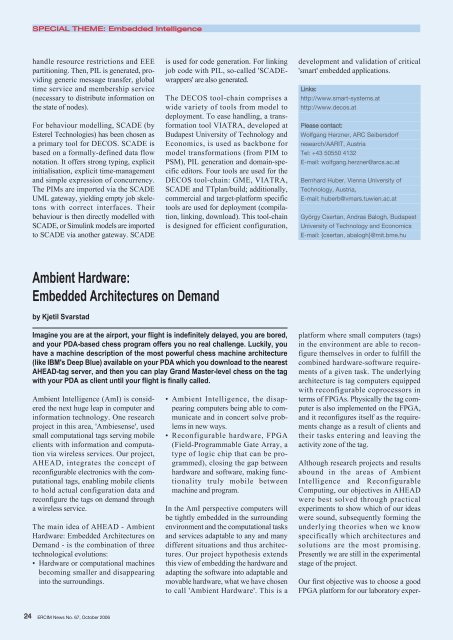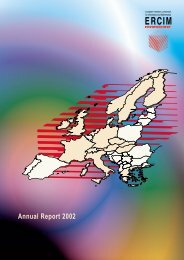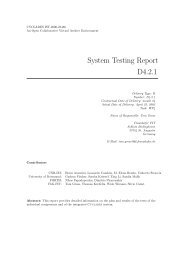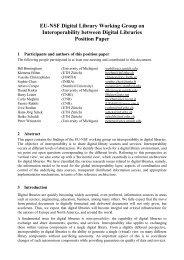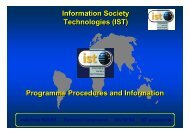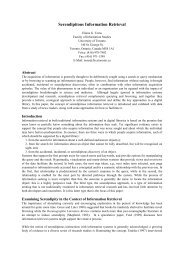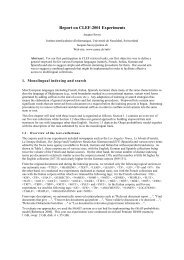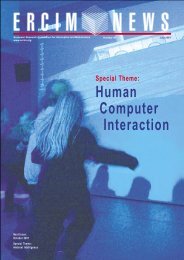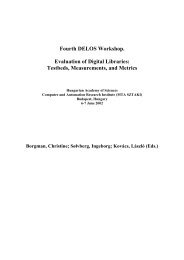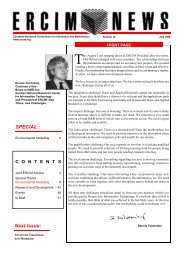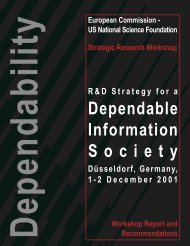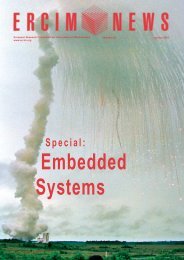Towards a Platform for Widespread Embedded Intelligence - ERCIM
Towards a Platform for Widespread Embedded Intelligence - ERCIM
Towards a Platform for Widespread Embedded Intelligence - ERCIM
You also want an ePaper? Increase the reach of your titles
YUMPU automatically turns print PDFs into web optimized ePapers that Google loves.
SPECIAL THEME: <strong>Embedded</strong> <strong>Intelligence</strong><br />
handle resource restrictions and EEE<br />
partitioning. Then, PIL is generated, providing<br />
generic message transfer, global<br />
time service and membership service<br />
(necessary to distribute in<strong>for</strong>mation on<br />
the state of nodes).<br />
For behaviour modelling, SCADE (by<br />
Esterel Technologies) has been chosen as<br />
a primary tool <strong>for</strong> DECOS. SCADE is<br />
based on a <strong>for</strong>mally-defined data flow<br />
notation. It offers strong typing, explicit<br />
initialisation, explicit time-management<br />
and simple expression of concurrency.<br />
The PIMs are imported via the SCADE<br />
UML gateway, yielding empty job skeletons<br />
with correct interfaces. Their<br />
behaviour is then directly modelled with<br />
SCADE, or Simulink models are imported<br />
to SCADE via another gateway. SCADE<br />
Ambient Hardware:<br />
<strong>Embedded</strong> Architectures on Demand<br />
by Kjetil Svarstad<br />
24 <strong>ERCIM</strong> News No. 67, October 2006<br />
is used <strong>for</strong> code generation. For linking<br />
job code with PIL, so-called 'SCADEwrappers'<br />
are also generated.<br />
The DECOS tool-chain comprises a<br />
wide variety of tools from model to<br />
deployment. To ease handling, a trans<strong>for</strong>mation<br />
tool VIATRA, developed at<br />
Budapest University of Technology and<br />
Economics, is used as backbone <strong>for</strong><br />
model trans<strong>for</strong>mations (from PIM to<br />
PSM), PIL generation and domain-specific<br />
editors. Four tools are used <strong>for</strong> the<br />
DECOS tool-chain: GME, VIATRA,<br />
SCADE and TTplan/build; additionally,<br />
commercial and target-plat<strong>for</strong>m specific<br />
tools are used <strong>for</strong> deployment (compilation,<br />
linking, download). This tool-chain<br />
is designed <strong>for</strong> efficient configuration,<br />
Imagine you are at the airport, your flight is indefinitely delayed, you are bored,<br />
and your PDA-based chess program offers you no real challenge. Luckily, you<br />
have a machine description of the most powerful chess machine architecture<br />
(like IBM's Deep Blue) available on your PDA which you download to the nearest<br />
AHEAD-tag server, and then you can play Grand Master-level chess on the tag<br />
with your PDA as client until your flight is finally called.<br />
Ambient <strong>Intelligence</strong> (AmI) is considered<br />
the next huge leap in computer and<br />
in<strong>for</strong>mation technology. One research<br />
project in this area, 'Ambiesense', used<br />
small computational tags serving mobile<br />
clients with in<strong>for</strong>mation and computation<br />
via wireless services. Our project,<br />
AHEAD, integrates the concept of<br />
reconfigurable electronics with the computational<br />
tags, enabling mobile clients<br />
to hold actual configuration data and<br />
reconfigure the tags on demand through<br />
a wireless service.<br />
The main idea of AHEAD - Ambient<br />
Hardware: <strong>Embedded</strong> Architectures on<br />
Demand - is the combination of three<br />
technological evolutions:<br />
• Hardware or computational machines<br />
becoming smaller and disappearing<br />
into the surroundings.<br />
• Ambient <strong>Intelligence</strong>, the disappearing<br />
computers being able to communicate<br />
and in concert solve problems<br />
in new ways.<br />
• Reconfigurable hardware, FPGA<br />
(Field-Programmable Gate Array, a<br />
type of logic chip that can be programmed),<br />
closing the gap between<br />
hardware and software, making functionality<br />
truly mobile between<br />
machine and program.<br />
In the AmI perspective computers will<br />
be tightly embedded in the surrounding<br />
environment and the computational tasks<br />
and services adaptable to any and many<br />
different situations and thus architectures.<br />
Our project hypothesis extends<br />
this view of embedding the hardware and<br />
adapting the software into adaptable and<br />
movable hardware, what we have chosen<br />
to call 'Ambient Hardware'. This is a<br />
development and validation of critical<br />
'smart' embedded applications.<br />
Links:<br />
http://www.smart-systems.at<br />
http://www.decos.at<br />
Please contact:<br />
Wolfgang Herzner, ARC Seibersdorf<br />
research/AARIT, Austria<br />
Tel: +43 50550 4132<br />
E-mail: wolfgang.herzner@arcs.ac.at<br />
Bernhard Huber, Vienna University of<br />
Technology, Austria,<br />
E-mail: huberb@vmars.tuwien.ac.at<br />
György Csertan, Andras Balogh, Budapest<br />
University of Technology and Economics<br />
E-mail: {csertan, abalogh}@mit.bme.hu<br />
plat<strong>for</strong>m where small computers (tags)<br />
in the environment are able to reconfigure<br />
themselves in order to fulfill the<br />
combined hardware-software requirements<br />
of a given task. The underlying<br />
architecture is tag computers equipped<br />
with reconfigurable coprocessors in<br />
terms of FPGAs. Physically the tag computer<br />
is also implemented on the FPGA,<br />
and it reconfigures itself as the requirements<br />
change as a result of clients and<br />
their tasks entering and leaving the<br />
activity zone of the tag.<br />
Although research projects and results<br />
abound in the areas of Ambient<br />
<strong>Intelligence</strong> and Reconfigurable<br />
Computing, our objectives in AHEAD<br />
were best solved through practical<br />
experiments to show which of our ideas<br />
were sound, subsequently <strong>for</strong>ming the<br />
underlying theories when we know<br />
specifically which architectures and<br />
solutions are the most promising.<br />
Presently we are still in the experimental<br />
stage of the project.<br />
Our first objective was to choose a good<br />
FPGA plat<strong>for</strong>m <strong>for</strong> our laboratory exper-


